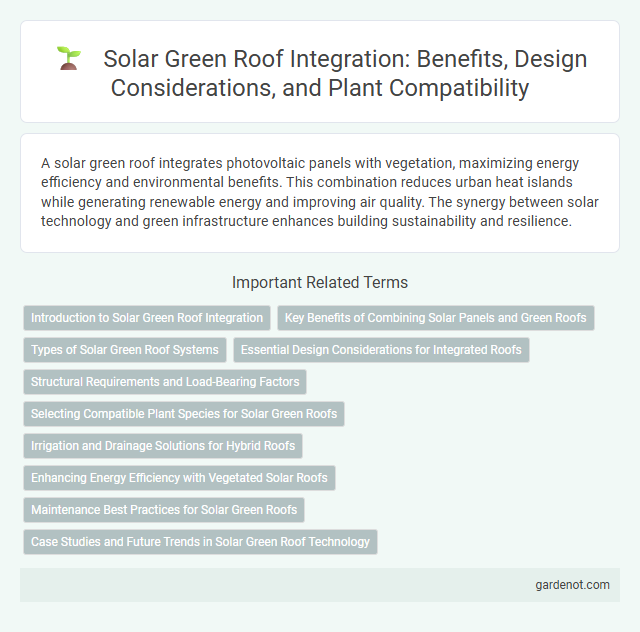A solar green roof integrates photovoltaic panels with vegetation, maximizing energy efficiency and environmental benefits. This combination reduces urban heat islands while generating renewable energy and improving air quality. The synergy between solar technology and green infrastructure enhances building sustainability and resilience.
Introduction to Solar Green Roof Integration
Solar green roof integration combines photovoltaic panels with vegetative roofing systems to enhance energy efficiency and environmental sustainability. This hybrid solution optimizes urban space by simultaneously generating renewable energy and improving insulation, reducing building energy consumption by up to 30%. Advanced solar green roofs also promote biodiversity, mitigate heat island effects, and improve stormwater management, making them a multifunctional asset in sustainable architecture.
Key Benefits of Combining Solar Panels and Green Roofs
Integrating solar panels with green roofs enhances energy efficiency by reducing rooftop temperatures, which improves photovoltaic performance and extends panel lifespan. This combination promotes sustainable urban development by providing natural insulation, lowering heating and cooling demands while generating clean, renewable energy. Additionally, solar green roofs contribute to stormwater management and biodiversity, creating multifunctional ecosystems in densely populated areas.
Types of Solar Green Roof Systems
Solar green roof systems combine photovoltaic panels with vegetative roofing to enhance energy efficiency and environmental benefits. Types include integrated solar green roofs, where solar panels are embedded within the vegetation layer, and hybrid solar green roofs featuring raised solar arrays above planting zones to optimize sunlight exposure and plant growth. Each type balances energy generation with ecological advantages, improving building insulation and reducing urban heat islands.
Essential Design Considerations for Integrated Roofs
Solar green roofs require strategic placement of photovoltaic panels to maximize sunlight exposure while maintaining optimal vegetation growth. Incorporating lightweight, durable materials ensures structural integrity under combined loads of solar equipment and plant substrates. Proper drainage and irrigation design are critical to support both solar panel performance and healthy plant root systems.
Structural Requirements and Load-Bearing Factors
Solar green roofs require careful consideration of structural requirements, including the roof's load-bearing capacity to support both the weight of photovoltaic panels and the additional green roof system components. Load-bearing factors must account for the combined dead loads of soil, vegetation, solar equipment, and potential live loads such as snow or maintenance personnel. Engineering assessments and reinforcements ensure the roof structure maintains integrity under these cumulative stresses while optimizing energy generation and sustainable benefits.
Selecting Compatible Plant Species for Solar Green Roofs
Selecting compatible plant species for solar green roofs involves prioritizing drought-tolerant, low-maintenance plants that can thrive under solar panel shading and elevated temperatures. Succulents, sedums, and native grasses are ideal as they require minimal irrigation and support the microclimate around photovoltaic systems. Integrating these species optimizes energy efficiency and extends the lifespan of solar panels by reducing heat buildup on the roof surface.
Irrigation and Drainage Solutions for Hybrid Roofs
Solar green roofs integrate advanced irrigation and drainage solutions to optimize water management and support both vegetation and photovoltaic panels. Smart irrigation systems use sensors to monitor soil moisture levels, ensuring efficient water distribution that prevents over-saturation and conserves resources. Engineered drainage layers facilitate rapid water runoff, protecting solar equipment while maintaining the health of the green roof ecosystem.
Enhancing Energy Efficiency with Vegetated Solar Roofs
Vegetated solar roofs integrate photovoltaic panels with green roofing systems, significantly improving building energy efficiency by reducing heat absorption and lowering cooling demands. The combination of solar energy generation and natural insulation from vegetation promotes sustainable energy use and decreases reliance on conventional power sources. Research shows these systems can boost solar panel performance by maintaining lower temperatures, increasing overall energy output by up to 15%.
Maintenance Best Practices for Solar Green Roofs
Regular inspection of solar panels and roof membranes ensures optimal energy efficiency and prevents water infiltration on solar green roofs. Cleaning panels to remove dust, debris, and plant overgrowth maximizes sunlight absorption and enhances photovoltaic performance. Integrating routine maintenance schedules with irrigation management supports plant health while safeguarding the durability of solar equipment.
Case Studies and Future Trends in Solar Green Roof Technology
Case studies on solar green roofs demonstrate enhanced energy efficiency and urban heat island mitigation by integrating photovoltaic panels with vegetation, resulting in reduced building cooling costs and improved air quality. Emerging trends in solar green roof technology emphasize flexible, lightweight solar cells and smart irrigation systems to optimize energy output and plant health. Future developments aim to incorporate advanced materials and IoT monitoring for scalable, sustainable urban energy solutions.
Solar green roof Infographic

 gardenot.com
gardenot.com